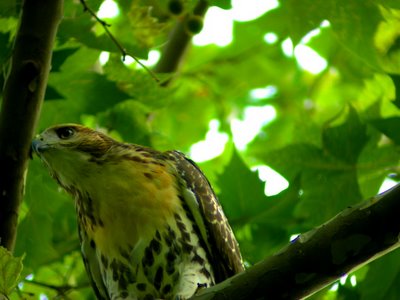
Photograph by Donegal Browne
Eyass? Fledgling? Both?
From Ben Cacace...
John,
Thanks for the follow-up to my error in thinking eyass was only the nestling phase. This was gathered from my reading of texts over the past ten years and missing the use of this term during the fledgling stage.
I just checked Wheeler's 'Raptors of Eastern North America' and he has:
Eyass. Nestling or fledgling falcon.
Ben
P.S. - Whenever I referred to the young Red-tailed Hawks in a nest I always referred to them as nestlings.
More on raptor terms from John Blakeman...
I failed to describe some other raptor and falconry terms that, in the end, can be useful.
Just as a female horse is a mare, and a male a stallion (or if "fixed," a gelding), the sexes of hawks have specific names (sort of).
Let's start with the simplest and most straightforward. The term is "tiercel" (or "tercel" -- like the others, these are old English words, from a time when orthography, agreed-upon spelling, didn't much exist). A tiercel is a male hawk of any kind. Pale Male is a tiercel supreme. The word, as I understand it, derives from an early French word meaning "one third." That's because peregrine tiercels are about one third smaller than peregrine females. Virtually all male raptors are smaller than females (which is a whole 'nother topic we won't go into here).
(More on sexual dimorphism in hawks when it comes to size in the archives of Marie Winn's wonderful site...www.mariewinn.com/ D. B.)
The male is a tiercel. What's the female? If she's a peregrine, she's the falcon. In the strictest usage, a falcon is the female of any of the authentic falcons (genus Falco). In earlier times (as in many lines of Shakespeare), one can fly a "peregrine," a type of hawk. One could fly a peregrine tiercel, a smaller male, or a peregrine falcon, the larger female.
Of course, today a peregrine falcon is an entire species, not the sex. But falconers still understand the original usage, and wince a bit when someone speaks of a tiercel falcon (a "male female"). Consequently, falconers have to be judicious in how they use the terms "tiercel" and "falcon."
The real problem is with the red-tail and other non-falcon hawks. Pale Male is a fine red-tail tiercel. But he's never had a red-tail falcon as a mate. There is no such thing. Female red-tails lack a fine English name from four centuries ago. That's because red-tailed hawks aren't found in Europe, so they were never used for falconry there. Today, female red-tails are commonly referred to as "hens," a term as deficient as "chick" for an eyass in my mind. A hen is a female chicken, and my female red-tail far eclipses any chicken hen I've ever seen.
Late at night I've tried to come up with some new contemporary word that would be applied to female red-tails, a term that would connote or suggest the same sort of identifiable traits that the wonderful term "tiercel" does for males. So far, I've come up with nothing. And even if I did, my powers of persuading my fellow falconers to adopt the new term would be nil. Falconers, as you can imagine, are a somewhat contentious lot not easily given to otherwise arbitrary new terms. So lacking any early English precedents, female red-tails are (somewhat ignominiously) still just "hens." (I cringe.)
The last thing I'll touch on is the difference between a falcon and a hawk. This could go on for many pages, but I'll limit it to just general hawks and falcons. In short, all falcons are hawks. A falcon (a species, not a female) is a specific kind of hawk, with long, powerful wings, etc. Falcons are all in the genus Falco. There are many kinds of hawk, in many genera (closely related taxonomic groupings). A falcon is a specific kind of hawk.
That's enough of all of that.
--John Blakeman
No comments:
Post a Comment